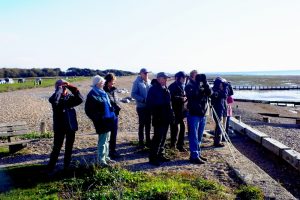To a record audience of over 100 members and visitors Professor Fiona Matthews from the University of Sussex and Chairman of the Mammal Society, presented an illustrated talk entitled ‘Hedgehogs and their Conservation’.
Professor Matthews explained that hedgehogs are one of our most appealing mammals but they seem to be in long-term decline in Great Britain, and there is an urgent need to shed light on where they are most scarce and where they could and should be thriving. This critical information will help conservationists understand what can be done to reverse this decline.
Using the Mammal Society’s HogWatch2019 online survey Professor Matthews encouraged members to record their hedgehog sightings and, just as importantly, where hedgehogs are no longer in evidence to give a clearer picture of the overall position and to contribute to the latest conservation research. There is also a Mammal Mapper App that can be downloaded which is an easy way to record hedgehog sightings and especially good for interested children.
Climate change, loss of habitat, use of pesticides and changes in agricultural practice have all had a devastating effect. Road deaths are also putting pressure on the hedgehog’s survival. It is also possible that badgers, whose numbers have increased in some areas in recent years, compete for the same kind of food and it may be that they are actually feeding on hedgehogs when food becomes scarce.
The modern British garden with its extended patios, decking, and minimalist style of planting has left little to attract hedgehogs. Professor Matthews urged members to leave appropriate corners of their garden untidy with piles of leaves and twigs for bedding, and to leave small gaps under fences or gates to allow hedgehogs the freedom to move around. She emphasised the need for us to do our bit and help turn the tide for this charismatic little mammal.
As is traditional at the last meeting of the year, warm mince pies were served with the usual cup of tea and Tricia Hall followed this welcome treat with her ever popular Nature Notes. This month she introduced a delightful film entitled ‘A Few Birds around Ferring’, made around 5 years ago by her late husband Mike. With Mike’s valuable commentary the star of the film was undoubtedly a Snow Bunting that took great pleasure from preening itself with almost comical precision, as well as numerous waders, ducks and geese which made welcome appearances, including a brief glimpse of a Kingfisher.
A planning update followed to conclude the meeting with Ed Miller advising the Group that the planning application from the Andalucía Restaurant for two outside tables and chairs was refused by Arun DC. The office conversion at McIntyre’s Lane and the old Police Box conversion to a small residence were given approval. The decisions regarding the expansion of the Bluebird Café and the ninth apartment at Southpoint are due this month.

